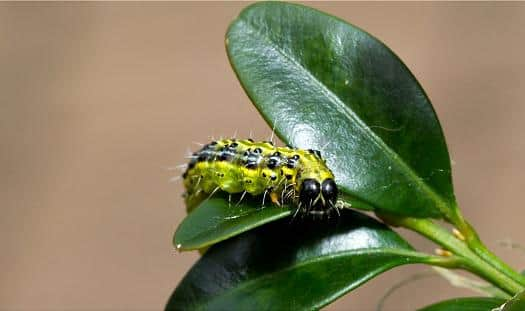Caterpillar tops list third year in a row for most pesky pest
The Royal Horticultural Society’s (RHS) annual list of the top plant pests and diseases faced by British gardens shows the box tree moth caterpillar was once again the top concern in 2019, as the species becomes more widespread.
The caterpillar, a native of East Asia first discovered in the UK in 2011, feeds vociferously on box plants under a blanket of pale fine webbing that can cover infected plants.
Advertisement
Hide AdAdvertisement
Hide AdThe charity’s analysis of thousands of queries from gardeners last year found the caterpillar triggered more inquiries than the rest of the top five pests combined.


The perennial foes of gardeners – slugs and snails – were only third in the pest rankings, coming in after vine weevils in second place.
Alder leaf beetle, which is unlikely to have long-term effects on trees but can cause defoliation, was in the top ten pest list for only the second time – perhaps as a result of an expansion of its range. It came in fifth place.
When it comes to plant diseases, honey fungus remained the most prominent problem – as it has been since the ranking started in 1995. But it dropped from more than a quarter of inquiries in 2018 to 18 per cent in 2019.
More rainfall last year, compared with 2018’s drought summer, meant fewer plants suffered from drought stress, which can be the final blow to plants that have lost much of their root system to the disease, the RHS said.
But brown rot of fruit and apple and pear scab were also of increasing concern to gardeners last year, taking fifth and seventh place, possibly as a result of the milder, wetter weather.
Brown rot is a fungal disease of apples, pears, plums, cherries and other fruit and ornamental trees, causing a brown, spreading rot in fruit. It is caused by the same fungi that cause blossom wilt in spring – which also made it into the top ten.
Unexpectedly, rose black spot turned up in the top ten, despite many gardeners knowing the signs and treatment for the disease, so the RHS is investigating the upsurge in inquiries.
Advertisement
Hide AdAdvertisement
Hide AdMatthew Cromey, principal scientist at the RHS, said: “Pests and diseases are among the main challenges we face as climate change affects our gardens and horticulture more widely.
“As the UK’s gardening knowledge bank, our research will help increase biosecurity and provide best practice.
“We want to develop a nation of gardeners equipped and motivated to deal with the challenges of our changing world.”
Comments
Want to join the conversation? Please or to comment on this article.
